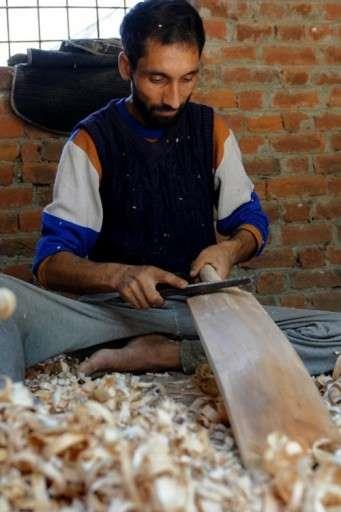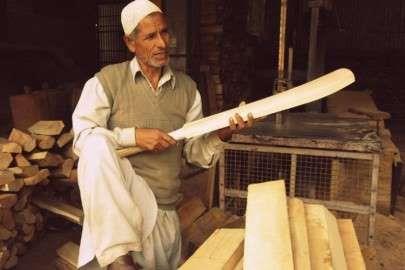November 8, 2014
A tourist in the Kashmir valley will often come across small stalls selling saffron, dry fruits or kahwa, with a sign outside the shop reading ‘Welcome to paradise on earth’. Not surprisingly, the picturesque terrain of that part of the world, marked by the magnificent Himalayan range, has mesmerized travellers for centuries.

November 8, 2014
A tourist in the Kashmir valley will often come across small stalls selling saffron, dry fruits or kahwa, with a sign outside the shop reading ‘Welcome to paradise on earth’. Not surprisingly, the picturesque terrain of that part of the world, marked by the magnificent Himalayan range, has mesmerized travellers for centuries.

Recent floods in Jammu and Kashmir has had an adverse effect on several bat manufacturing units in the state.
However, the region has faced continuous unrest due to its geographic position as the Indo-Pak border.
Tourism – an industry the local population thrives on – had taken a beating until just a few years ago, when the Indian government increased the deployment of security forces to and conflict was reduced in the state of Jammu and Kashmir.
But it is almost as if the province is under some ancient malediction – every time there’s a ray of hope, a bad situation occurs.
In September 2014, Jammu and Kashmir, Azad Kashmir, Gilgit-Baltistan and the Punjab district of Pakistan experienced heavy torrential rainfall that led to severe floods in these areas. Hundreds of families were displaced from their homes, prompting the home ministry to send out 82 aircrafts, 10 battalions of the Border Security Force, 329 columns of the army and 300 boats to carry out rescue operations.
But why is all this being written about in a cricket-specific space?
Jammu and Kashmir produces approximately 25 lakh units of ready-to-use and raw Kashmir willow (Salix fragilis) bats every year, generating a turnover of over Rs. 100 crores that almost 50,000 people in the state make a living from.
Most of these bats are manufactured around seven villages – Pujteng, Hallmullaha, Charsoo, Sangam, Sethar, Bijbehara and Mirzapur in South Kashmir.
The floods have had a great impact on cricket in the state, with crores worth of willow being washed away, and two venues where the state team play all their home games – Sher-i-Kashmir Stadium in Srinagar and the Gandhi Memorial Science College (GMSC) ground in Jammu – swamped by water.
Bats made from Kashmir Willow are popular among youngsters and domestic cricketers mainly because they come at a lower price than English willow bats. But some batsmen, who prefer a heavy blade for strokeplay, choose to use them even till state level tournaments.
Jalandhar and Meerut are home to most of the leading cricket goods sellers in the country, and Wisden India caught up with representatives from some of the biggest names in the industry, who, with the domestic season drawing closer, are now preparing for damage control to make up for the expected shortage in supply this year.
“Yes, we do generally sell more Kashmir Willow bats than English Willows in India,” said Paras Anand, Director of Marketing for Sanspareils Greenlands (SG), one of the most popular bat manufacturing companies in the world. “But that apart, we also export a lot of Kashmir willow bats to all cricket playing nations around the world.”
Anil Sareen, the chief executive officer of Stanford Cricket Industries (SF), who make bats for Dwayne Smith, Mahela Jayawardene, Lendl Simmons, Brendan Taylor and Daniel Vettori, agreed with Anand. “We sell more of the Kashmir willow in India in comparison to English willow because of the price that makes it affordable for most of the people who are starting to play cricket,” said Sareen. “Up to a certain standard, they continue using Kashmir willow.

Sachin Tendulkar, who contributed with five tons of eatables and 1000 blankets for the victims at the time of the floods, has also come forward to assist bat makers in the valley.
“The recent floods have badly affected the industry in Jammu and Kashmir and all of their stocks have gone down the river,” he added. “All their machinery got rusted and we have come to know that they have nothing to do (but) to restart all over because it will take time to get the trees back and cut (them) into shape and dry it. I think for another six month or so, this industry will suffer a lot.
“They have lost everything in these floods, and most of the people and the workers are also suffering because there is no raw material on which they can work on.”
Meanwhile, Sachin Tendulkar, who contributed with five tons of eatables and 1000 blankets for the victims at the time of the floods, has also come forward to assist bat makers in the valley.
“Our industry is helping them in Kashmir,” Sareen pointed out. “We have written to the government and additionally, Sachin Tendulkar happens to have written to us in the industry to find out how he can help the bat makers there.
“I think his contribution will be great for the industry. With Sachin’s influence and recommendation, all bank loan debts have been waived off with immediate effect for those in the cricket industry who suffered due to the floods.”
But given the current situation in Kashmir, will these bats, which usually range between Rs. 1200 to 4000, no longer remain affordable?
“The recent floods in Kashmir have not affected business for bat manufacturers yet in the short term,” said Anand. “But there certainly will be a marginal increase in price in the near future.”
Courtesy: Wisden India
















































































































